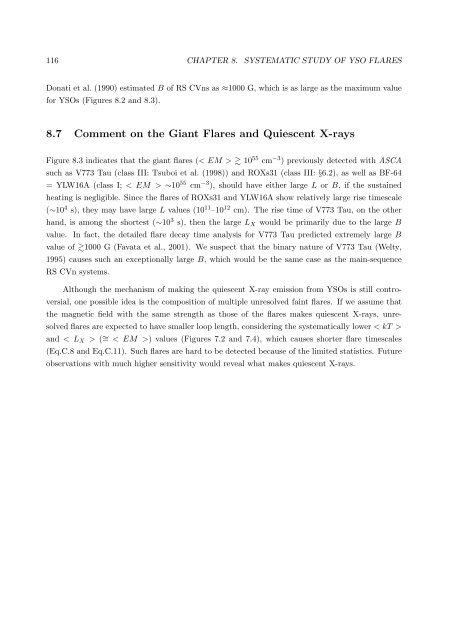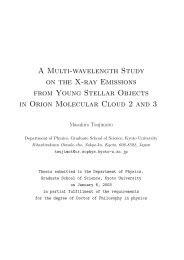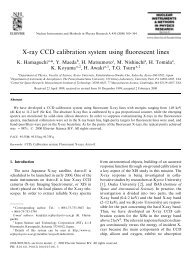X-ray Study of Low-mass Young Stellar Objects in the ρ Ophiuchi ...
X-ray Study of Low-mass Young Stellar Objects in the ρ Ophiuchi ...
X-ray Study of Low-mass Young Stellar Objects in the ρ Ophiuchi ...
Create successful ePaper yourself
Turn your PDF publications into a flip-book with our unique Google optimized e-Paper software.
116 CHAPTER 8. SYSTEMATIC STUDY OF YSO FLARESDonati et al. (1990) estimated B <strong>of</strong> RS CVns as ≈1000 G, which is as large as <strong>the</strong> maximum valuefor YSOs (Figures 8.2 and 8.3).8.7 Comment on <strong>the</strong> Giant Flares and Quiescent X-<strong>ray</strong>sFigure 8.3 <strong>in</strong>dicates that <strong>the</strong> giant flares (< EM > 10 55 cm −3 ) previously detected with ASCAsuch as V773 Tau (class III: Tsuboi et al. (1998)) and ROXs31 (class III: §6.2), as well as BF-64= YLW16A (class I; < EM > ∼10 55 cm −3 ), should have ei<strong>the</strong>r large L or B, if <strong>the</strong> susta<strong>in</strong>edheat<strong>in</strong>g is negligible. S<strong>in</strong>ce <strong>the</strong> flares <strong>of</strong> ROXs31 and YLW16A show relatively large rise timescale(∼10 4 s), <strong>the</strong>y may have large L values (10 11 –10 12 cm). The rise time <strong>of</strong> V773 Tau, on <strong>the</strong> o<strong>the</strong>rhand, is among <strong>the</strong> shortest (∼10 3 s), <strong>the</strong>n <strong>the</strong> large L X would be primarily due to <strong>the</strong> large Bvalue. In fact, <strong>the</strong> detailed flare decay time analysis for V773 Tau predicted extremely large Bvalue <strong>of</strong> 1000 G (Favata et al., 2001). We suspect that <strong>the</strong> b<strong>in</strong>ary nature <strong>of</strong> V773 Tau (Welty,1995) causes such an exceptionally large B, which would be <strong>the</strong> same case as <strong>the</strong> ma<strong>in</strong>-sequenceRS CVn systems.Although <strong>the</strong> mechanism <strong>of</strong> mak<strong>in</strong>g <strong>the</strong> quiescent X-<strong>ray</strong> emission from YSOs is still controversial,one possible idea is <strong>the</strong> composition <strong>of</strong> multiple unresolved fa<strong>in</strong>t flares. If we assume that<strong>the</strong> magnetic field with <strong>the</strong> same strength as those <strong>of</strong> <strong>the</strong> flares makes quiescent X-<strong>ray</strong>s, unresolvedflares are expected to have smaller loop length, consider<strong>in</strong>g <strong>the</strong> systematically lower < kT >and < L X > ( ∼ = < EM >) values (Figures 7.2 and 7.4), which causes shorter flare timescales(Eq.C.8 and Eq.C.11). Such flares are hard to be detected because <strong>of</strong> <strong>the</strong> limited statistics. Futureobservations with much higher sensitivity would reveal what makes quiescent X-<strong>ray</strong>s.

















